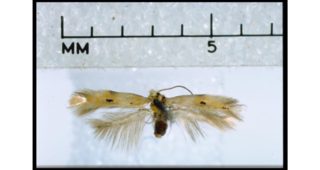
Stigmella insignis is a moth of the family Nepticulidae. It is endemic to New Zealand.
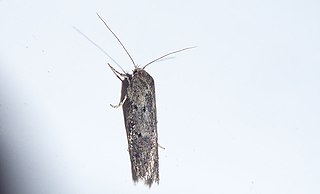
Leptocroca asphaltis is a moth of the family Oecophoridae. It was described by Edward Meyrick in 1911. It is endemic to New Zealand.

Hierodoris is a genus of moths in the family Oecophoridae. It was first described by Edward Meyrick in 1912. This genus is only known from New Zealand. In 1988 the genus Taoscelis was synonymised with Hierodoris. In 2005 the genus Coridomorpha was synonymised with Hierodoris.

Hierodoris frigida is a moth of the family Oecophoridae. It is endemic to New Zealand and is only found in the South Island. This species is found in two parts of that island, the Nelson/Tasman area and the Mackenzie, Otago and Dunedin areas in the southern part of the island. Although similar to H. iophanes this species can be distinguished as H. frigida has white bands on its forewings and the metallic coloured areas differ in placement. Segment 2 on the labial palp is entirely yellow and enables this species to be distinguished from the similar appearing species H. polita and H. torrida. Larvae have been collected amongst leaf litter from beneath species within the genus Thymus. It prefers open and shrubland habitats and adult moths have been observed flying close to the soil underneath Leptospermum scrub.
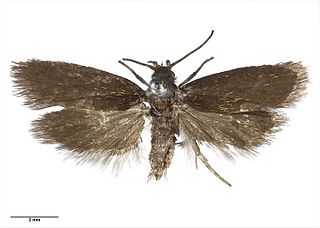
Hierodoris squamea is a moth of the family Oecophoridae. It is endemic to New Zealand and is found in the mountains of Fiordland as well as the Olivine Range in south Westland. This species has a wingspan of between 12 and 13 mm and can be distinguished from similar species as it is very small in size, has a reduced eyespot on its forewings, clearly visible through Scanning Electron Microscope preparations, and has orange-yellow scales overlaying its dark forewing. It prefers open country of tussock grasslands and herbfields at high altitudes. As at 2005 the larvae is unknown. Adults are on the wing in January.

Hierodoris insignis is a species of moth in the family Gelechiidae. It is endemic to New Zealand and has been found in the Nelson/Tasman districts. The larvae are leaf miners and are hosted by Celmisia species. Adults are on the wing in January. It is likely that this species belongs to another genus and as such this species is also known as Hierodoris (s.l.) insignis or 'Hierodoris' insignis.

Hierodoris stellata is a species of moth in the family Plutellidae. It is endemic to New Zealand and is found in Fiordland and Dunedin. This species has been found in coastal native forest. Larvae feed on Astelia flower-spikes and adults are on the wing in late December and January. It has been stated that this species belongs to the genus Charixena however this placement has yet to be published. As such this species is currently known as Hierodoris (s.l.) stellata or 'Hierodoris'stellata.
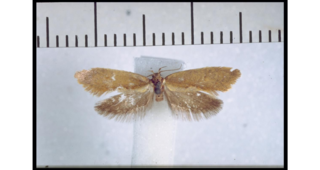
Tingena amiculata is a species of moth in the family Oecophoridae. It is endemic to New Zealand and has been observed in the Nelson, Tasman and Canterbury regions. This species has been collected amongst Hebe species and shrubland at altitudes of up to 4500 ft. It is similar in appearance to its near relatives Tingena basella and Tingena laudata.

Tingena chloritis is a species of moth in the family Oecophoridae. It is endemic to New Zealand and has been found in the South Island. Larvae of this species feed on leaf litter. The adults of this species are light flyers and are attracted to light.

Tingena maranta is a species of moth in the family Oecophoridae. It is endemic to New Zealand and is found in the lower South Island. Adults of this species are on the wing from October until January. This species perfers grass or low herb habitat. Unlike its close relatives it does not inhabit native forest.

Tingena nycteris is a species of moth in the family Oecophoridae. It is endemic to New Zealand and has been observed in the North and South Islands. This species inhabits native forest and scrubland and adults are on the wing from October to January.
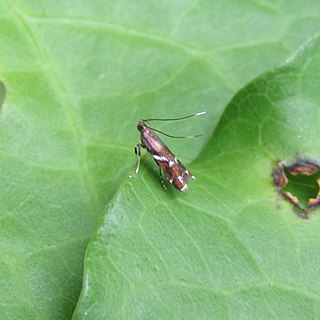
Compsistis bifaciella is a moth of the family Lecithoceridae. It is endemic to New Zealand and found throughout the North Island.

Atomotricha lewisi is a moth in the family Oecophoridae first described by Alfred Philpott in 1927. It is endemic to New Zealand.
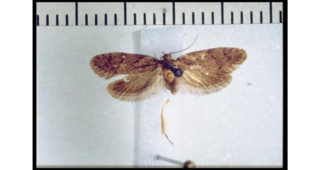
Euchersadaula tristis is a moth of the family Oecophoridae. It was first described by Alfred Philpott in 1926. This species is endemic to New Zealand.
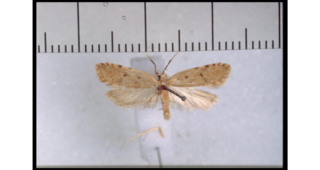
Gymnobathra primaria is a moth in the family Oecophoridae first described by Alfred Philpott in 1928. It is endemic to New Zealand. It has been hypothesised that this species likely belongs to another genus.
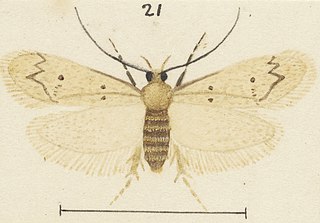
Leptocroca amenena is a moth of the family Oecophoridae first described by Edward Meyrick in 1883. It is endemic to New Zealand. The classification of this moth within the genus Leptocroca is regarded as unsatisfactory and in need of revision. As such this species is currently also known as Leptocroca (s.l.) amenena.

Leptocroca porophora is a moth of the family Oecophoridae first described by Edward Meyrick in 1929. It is endemic to New Zealand. The classification of this moth within the genus Leptocroca is regarded as unsatisfactory and in need of revision. As such this species is currently also known as Leptocroca (s.l.) porophora.
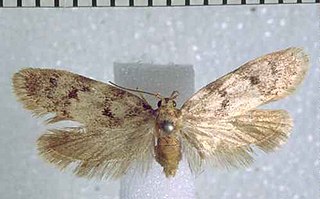
Leptocroca variabilis is a moth of the family Oecophoridae first described by Alfred Philpott in 1926. It is endemic to New Zealand. The classification of this moth within the genus Leptocroca is regarded as unsatisfactory and in need of revision. As such this species is currently also known as Leptocroca (s.l.) variabilis.
Leptocroca antinoma is a moth of the family Oecophoridae first described by Edward Meyrick in 1910. It is found in New Zealand at the Kermadec Islands and has also been collected in Australia.
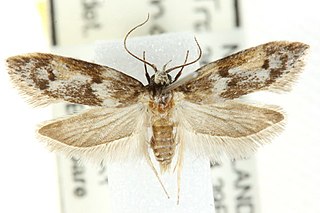
Trachypepla importuna is a moth of the family Oecophoridae first described by Edward Meyrick in 1927. This moth is regarded as having being introduced to New Zealand and is presumed to be native to Australia. T. importuna has been collected in both the North and South Islands of New Zealand. It inhabits native scrub and adults are on the wing in January and February. The placement of this species in the genus Trachypepla is regarded as being unsatisfactory and in need of revision.



















